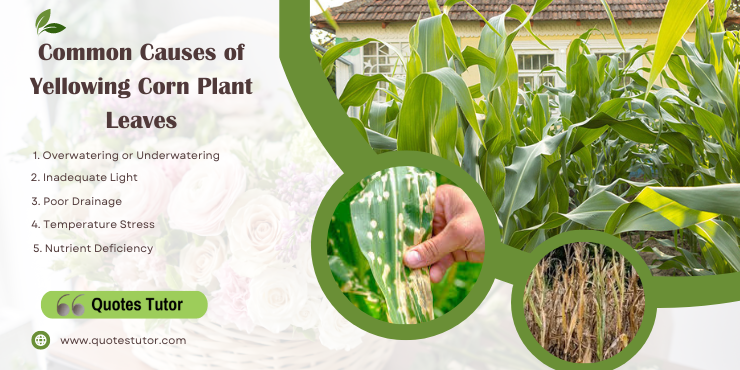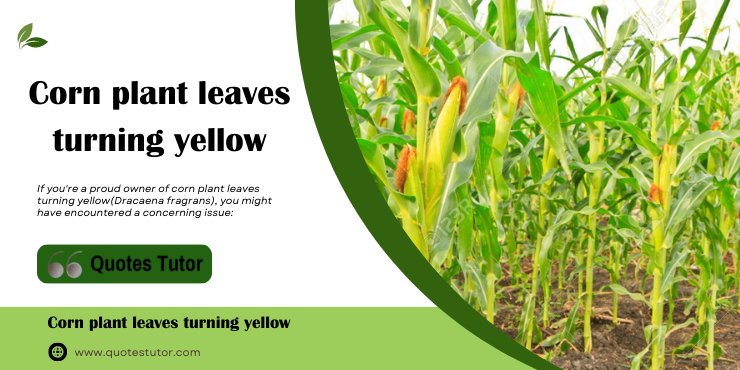If you’re a proud owner of corn plant leaves turning yellow (Dracaena fragrans), you might have encountered a concerning issue: the Corn plant leaves turning yellow. This phenomenon can be distressing, especially when you’re invested in maintaining the health and beauty of your indoor plants. Fortunately, understanding the reasons behind this yellowing can empower you to take effective steps to restore your corn plant’s vibrancy.
Common Causes of Corn plant leaves turning yellow

Corn plant leaves turning yellow, also known as Dracaena fragrans or cornstalk dracaena, are popular houseplants known for their vibrant green leaves. However, when the leaves start to turn yellow, it can be a cause for concern. There are several common causes of yellowing corn plant leaves that plant owners should be aware of.
1. Overwatering or Underwatering
Overwatering is a common mistake that many plant owners make. When a corn plant is overwatered, its roots become saturated, leading to poor oxygen supply and root rot. As a result, the plant’s ability to absorb nutrients is affected, causing its Corn plant leaves turning yellow. Signs of overwatering include wilting, mushy or smelly roots, and excessive moisture in the soil.
The most common reason for yellowing leaves in corn plants is improper watering. Overwatering can suffocate the roots, leading to root rot and nutrient deficiency. On the other hand, underwatering deprives the plant of essential hydration and nutrients.
2. Inadequate Light
Inadequate light is one of the common causes of yellowing corn plant leaves. Corn plants require sufficient sunlight to carry out photosynthesis, which is essential for the production of chlorophyll. When the plant does not receive enough light, it may start to show signs of stress by developing yellow leaves.
Corn plants thrive in bright, indirect light. If your plant isn’t receiving sufficient light, it can’t perform photosynthesis effectively, resulting in yellow leaves.
3. Poor Drainage
Poor drainage is a common cause of Corn plant leaves turning yellow. When the soil does not drain properly, excess water can accumulate around the plant’s roots, leading to root rot. This can prevent the roots from absorbing essential nutrients and oxygen from the soil, resulting in yellowing leaves. In addition, poor drainage can also cause nutrient imbalances in the soil, making it difficult for the plant to uptake necessary nutrients for healthy growth.
Therefore, ensuring proper drainage by addressing issues such as compacted soil, low-lying areas, or inadequate drainage systems is crucial for maintaining the vitality and greenness of corn plant leaves. Corn plants prefer well-draining soil. If the soil retains too much moisture, it can lead to root problems and yellowing leaves.
4. Temperature Stress
Temperature stress is a common factor that can cause Corn plant leaves turning yellow. When exposed to extreme temperatures, corn plants may experience physiological changes that affect their ability to properly photosynthesize and produce energy. High temperatures can lead to a process called photoinhibition, where the plant’s photosynthetic apparatus becomes damaged and unable to function efficiently. This results in a decrease in chlorophyll production, leading to yellowing of the leaves.
Overall, it is important for farmers and gardeners to closely monitor temperature fluctuations and provide appropriate care to prevent and mitigate the adverse effects of temperature stress on corn plants. Extreme temperatures, whether too cold or too hot, can stress the corn plant and cause its leaves to turn yellow.
5. Nutrient Deficiency
Nutrient deficiency is a common problem that can lead to Corn plant leaves turning yellow. When corn plants do not receive adequate amounts of essential nutrients, their growth becomes stunted and their leaves turn yellow. There are several common causes of nutrient deficiency in corn plants, including a lack of nitrogen, phosphorus, potassium, or iron.
These nutrients are essential for the healthy development of corn plants, and without them, the plants cannot produce chlorophyll, which gives leaves their green color. Other factors that can contribute to nutrient deficiency in corn plants include poor soil quality, improper fertilization practices, and environmental factors such as drought or excessive rainfall. A lack of essential nutrients, such as nitrogen, potassium, or iron, can manifest as yellowing leaves. This often occurs in plants that haven’t been fertilized properly.
Remedies to Revive Your Corn plant leaves turning yellow

If you are a proud owner of a corn plant (Dracaena fragrans), also known as a cornstalk plant, you know how stunning its lush, green foliage can be. However, like any living thing, your corn plant may occasionally need a little extra care and attention to stay healthy and thrive. Whether it is due to overwatering, lack of sunlight, or other environmental factors, if your corn plant is showing signs of distress, don’t worry – there are remedies you can try to revive it.
1. Adjust Watering Routine
If your corn plant is looking a bit limp and dry, it may be time to adjust your watering routine to revive it. This article provides various remedies and solutions to help bring your corn plant back to life. From determining the right amount of water to understanding signs of overwatering or underwatering, this guide walks you through the steps to rejuvenate your plant.
With these remedies, your corn plant will be healthy and vibrant in no time. Evaluate the moisture needs of your corn plant by checking the top inch of the soil. Water when it’s slightly dry, and ensure proper drainage to prevent overwatering.
2. Optimize Lighting
If your corn plant is wilting or not looking as healthy as you’d like, it may be due to improper lighting conditions. This article provides a comprehensive guide on how to optimize lighting for your corn plant to help it thrive. It covers various remedies and solutions, including understanding the ideal lighting requirements for corn plants, troubleshooting common lighting issues, and utilizing artificial lighting options when natural light is insufficient.
By following these lighting remedies, you can revitalize your corn plant and promote its growth and overall health. Place your corn plant in a location with bright, indirect light. Rotate the plant periodically to ensure all sides receive adequate light exposure.
3. Repot with Well-Draining Soil
If your corn plant is not thriving and looking a bit lackluster, it could be due to the soil it’s planted in. This article offers remedies and solutions to revive your corn plant by repotting it with well-draining soil. It provides guidance on identifying signs of poor soil drainage, understanding the importance of well-draining soil for corn plants, and how to properly repot your plant to improve its soil conditions.
By following these repotting remedies, you can give your corn plant a fresh start and help it thrive. If your plant’s current soil retains too much moisture, consider repotting it using a well-draining mix to prevent root issues.
4. Temperature Regulation
If your corn plant is struggling to regulate its temperature and is showing signs of stress, this article is here to help. It provides a range of remedies and solutions to revive your corn plant by addressing temperature regulation issues. The article covers topics such as identifying signs of temperature stress, understanding the optimal temperature range for corn plants, and implementing measures to regulate temperature, such as adjusting room temperature, using fans or heaters, and providing insulation.
By following these temperature regulation remedies, you can revive your corn plant and create the ideal environment for its growth and vitality. . Maintain a comfortable room temperature to avoid stress.
5. Fertilize Appropriately
If your corn plant is looking a bit lackluster and not growing as well as you’d like, it may be time to focus on fertilization. This article provides a comprehensive guide on how to fertilize your corn plant appropriately to revive its health. . Additionally, the article offers practical tips on how to apply fertilizer correctly, including the right timing and dosage.
By following these fertilization remedies, you can provide your corn plant with the necessary nutrients to promote growth and vitality. Feed your corn plant with a balanced liquid fertilizer every 2-4 weeks during the growing season. This will provide the necessary nutrients for healthy foliage.
Final Thought:
Witnessing your beloved corn plant leaves turning yellow can be worrisome, but it’s important to remember that this is often a sign of a manageable issue. By understanding the root causes and implementing the appropriate remedies, you can restore your corn plant to its lush, green glory.
FAQs About Corn plant leaves turning yellow
1. How often should I water my corn plant?
Water your corn plant when the top inch of the soil feels slightly dry to the touch.
2. Can I place my corn plant in direct sunlight?
No, corn plants prefer bright, indirect light. Direct sunlight can scorch their leaves.
3. Should I mist my corn plant’s leaves?
Misting can be beneficial to increase humidity, but avoid misting excessively as it can lead to fungal issues.
4. What is the best time to repot my corn plant?
Spring is the ideal time to repot your corn plant, as it’s the active growing season.
5. Why are the tips of my corn plant’s leaves turning brown?
Brown leaf tips can indicate low humidity. Consider misting the plant or using a humidifier nearby.

Pingback: Yellow leaves on corn plant